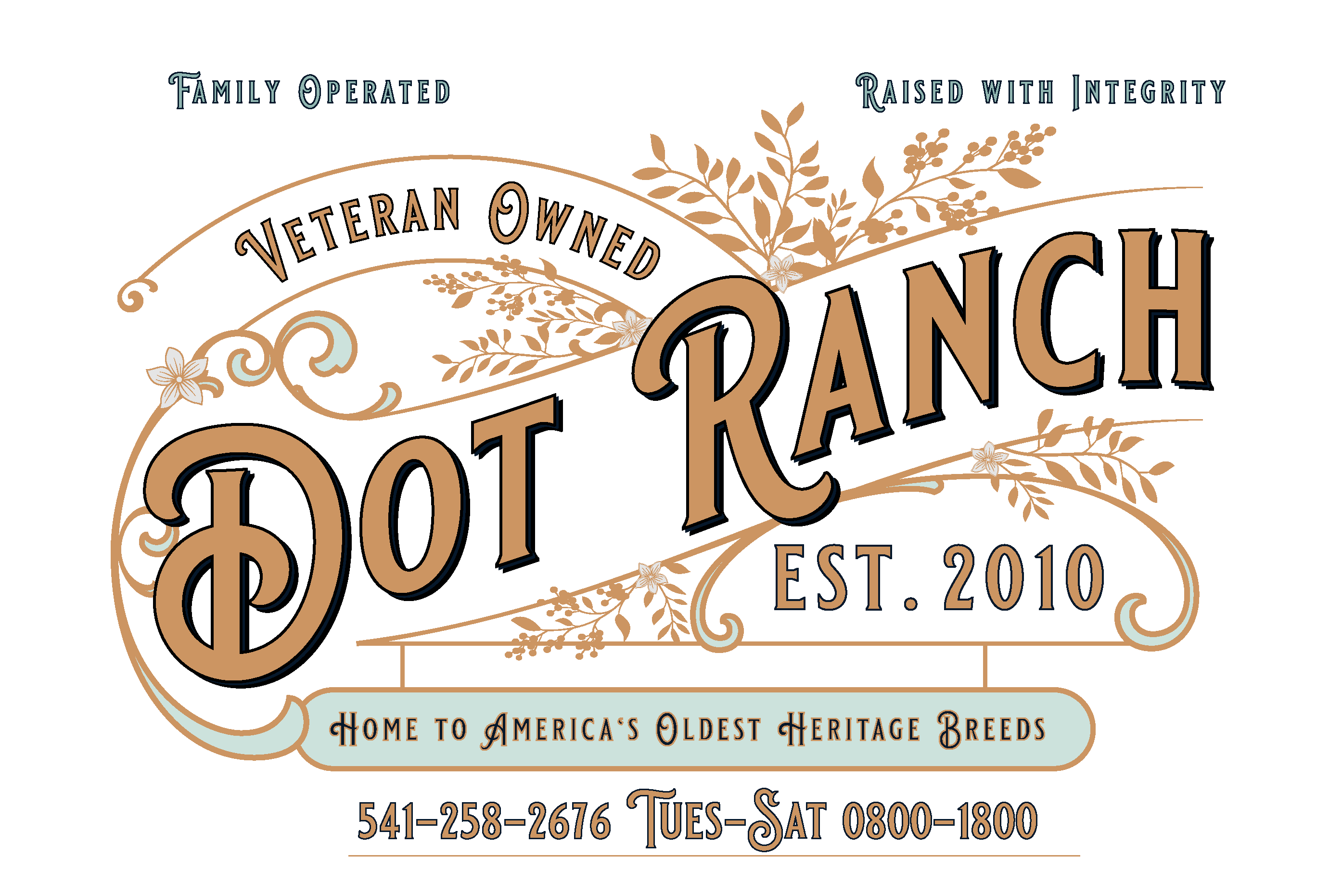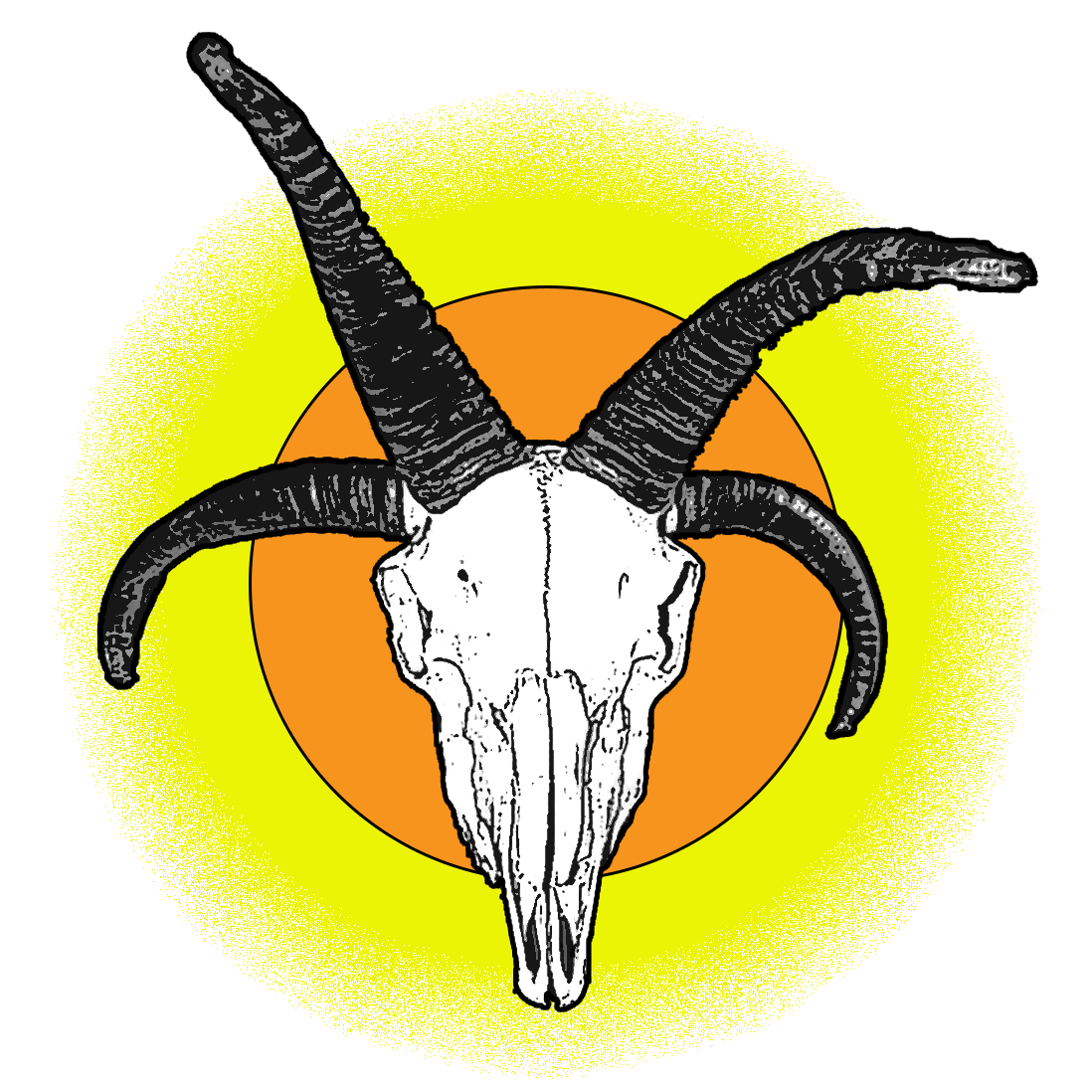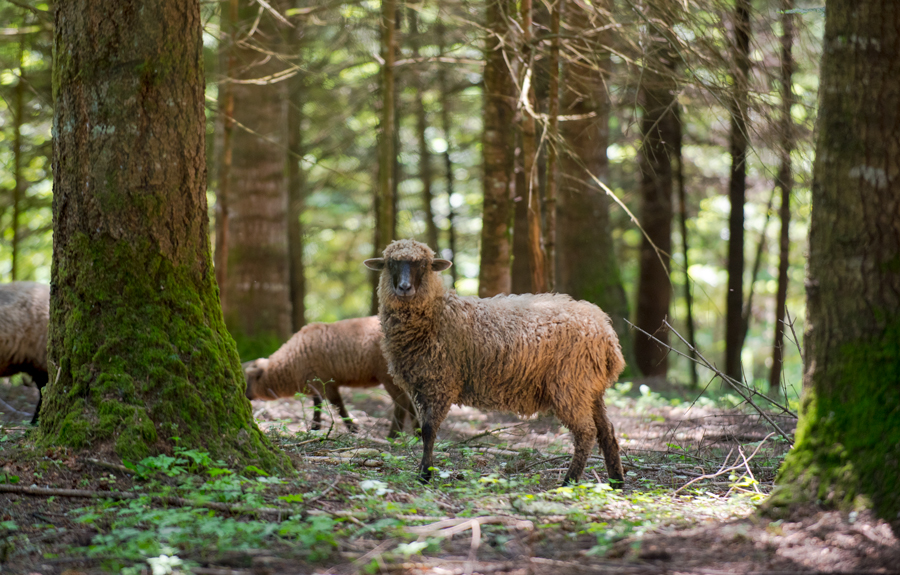
Dot Ranch: Philosophy, History, and Goals
Be good to the land, and the land will be good to you.
The philosophy of Dot Ranch is pretty simple, when it all comes down to it. We believe that success comes with balance, and that balance can only be attained by including ourselves in the equation. Too often, humans consider themselves outside of nature, when in reality, every action we take affects not only those people around us, but also the environment we live in, the animals that abide with us, and the generations yet to come.
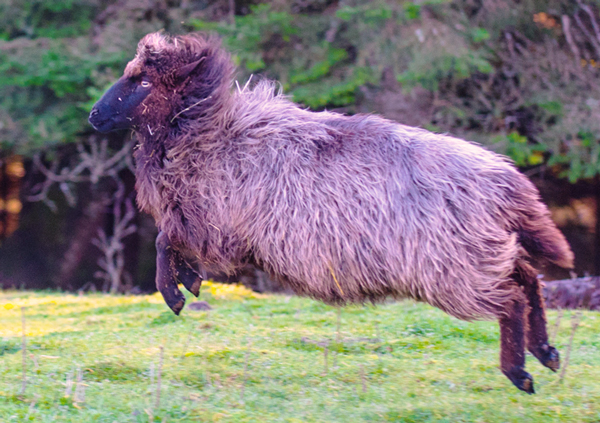 We believe that animals are due dignity and a high quality of life, even when they are destined for the table. This is why we name all of our animals, because we believe that animals with names are treated with more respect and love. While not all of our customers want to know the names of the ones they eat, to some, knowing and recognizing that sacrifice is an important part of their sense of connection and humility.
We believe that animals are due dignity and a high quality of life, even when they are destined for the table. This is why we name all of our animals, because we believe that animals with names are treated with more respect and love. While not all of our customers want to know the names of the ones they eat, to some, knowing and recognizing that sacrifice is an important part of their sense of connection and humility.
We believe that the land should be treated with respect, that water is sacred, and that without consideration, even stone will erode away. Ranching is, by its nature, prone to become exploitive without care, and we believe that it takes active and consistent choices to maintain our balance between economics and environmental health.
We believe that wealth isn't confined to dollar bills, it's also held in sunshine, fresh air, rain, grass, and the trees that arch above us. The wildlife that make their homes here are equally valuable, and we always strive to live as part of our ecosystem, not as though we were outsiders. If we lose some chickens or even some lambs, that is part of the price we pay to live in balance with those around us, and it reminds us to consider that every animal has its needs, even if they aren't always in line with our own. There is a richness in culture, history, and human experience with our livestock which stretches back farther than our own lives. Respecting that is more than paying lip service, it is a way of life.
We also believe in standing up for what is right, even against a chorus of opposition. It's an unfortunate fact that engaging in sustainable agriculture in the United States is often a political statement. It's definitely a moral one, and furthermore, as a family of mixed ethnic heritage, we will ALWAYS stand for the voices of our sisters and brothers of ALL ethnicities. Too often, people visualize farmers and ranchers as being some monolithic mess of good ol boys and plump, elderly white men on tractors, ignoring the fact that most of the world is farmed by those who are black and brown. Food justice and environmental justice have become inextricably woven with matters of ethnicity as the staggering effects of seed patenting, deforestation, centralization of crops, and destabilizing of developing nation's governments are felt. Food stability is a plight that hits close to home, for even here in the United States there are vast and disproportionate effects of hunger and malnutrition on communities of color. It is our belief that these injustices cannot be attacked only from the outside, they need to be addressed from within our own communities, and with our own voices.

Humble Beginnings, and The Merits of Researching First.
Building a successful ranch doesn't happen overnight, and it takes more than just buying some land and throwing animals on it to make it all work. When I first started looking for land to buy, I already had a pretty good idea what I wanted, and what I wanted to do with it. Being a disabled veteran comes with a few quirks, among them, a love for space and privacy. When I found this ranch, it had been owned by a WWII veteran who had ran beef cattle on it for 25 years. He'd let the cattle go about five years prior to selling, and the undergrowth in the forest was already an out of control fire hazard of ladder fuels and invasive species. But the elements were already here: a modest but functional barn, some fencing in poor but mostly functional state, a beautiful cattle handling yard with an older and well built cattle squeeze, and of course, acres and acres of grass. The wells were low producing, and the water quality was a bit questionable, but the view was fantastic, and there were no neighbors on two sides of the property. In short, it seemed like the perfect place to start from.
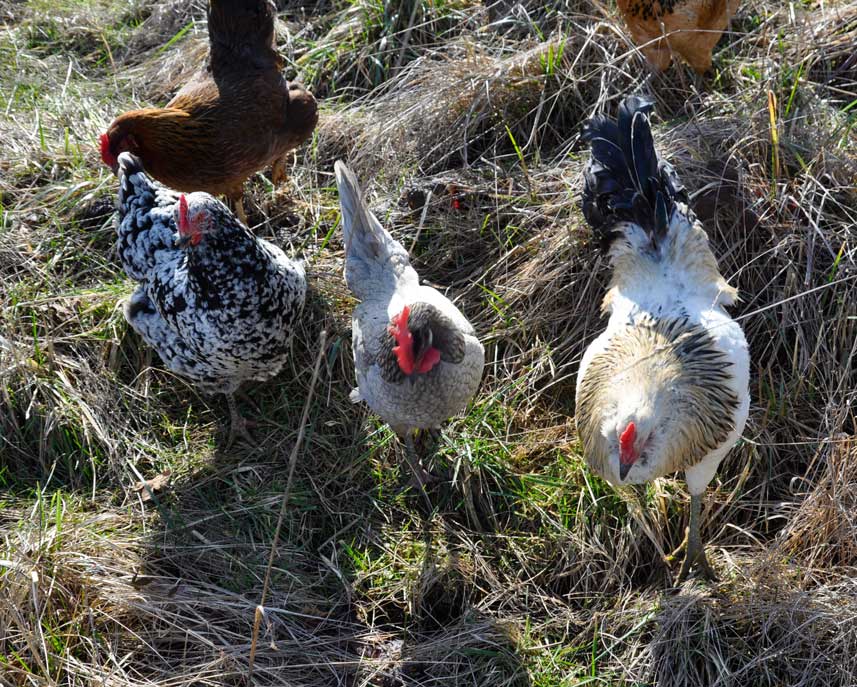 People make jokes about chickens being the gateway drug of the agricultural world, but there's a bit of truth to that. Like many small farms, we started out with poultry first. Our original flock was the typical barnyard mix of a rainbow of birds,
mostly heritage breeds, with a few Frankenchicken broilers thrown in for contrast. The Muscovy ducks followed shortly after, not so incidentally at the height of fly season. Online research had let me discover that adding Muscovys to a ranch could reduce fly populations significantly, and I always have preferred duck meat to chicken. Within the first year, we'd discovered that most heritage breeds of chickens are no less prone to being lifted off by hawks than contemporary breeds, and they were a lot more difficult to replace. An accidental craigslist discovery of some Mottled Java hens (that beautiful black and white hen to the left) led me to a trove of American agricultural history, and after watching nearly every other bird disappear while the Javas stayed strong, I decided to begin breeding them, along with the Black Copper Marans which were deeply in vogue at the time. Since, we've quit breeding the BCM's, and now are focused on Mottled Java's and developing our own new breed, Javarans.
Javarans will most likely never be recognized by the APA, but they are a hardy homesteader bird with a rich milk chocolate egg, and we make brisk local sales with them.
People make jokes about chickens being the gateway drug of the agricultural world, but there's a bit of truth to that. Like many small farms, we started out with poultry first. Our original flock was the typical barnyard mix of a rainbow of birds,
mostly heritage breeds, with a few Frankenchicken broilers thrown in for contrast. The Muscovy ducks followed shortly after, not so incidentally at the height of fly season. Online research had let me discover that adding Muscovys to a ranch could reduce fly populations significantly, and I always have preferred duck meat to chicken. Within the first year, we'd discovered that most heritage breeds of chickens are no less prone to being lifted off by hawks than contemporary breeds, and they were a lot more difficult to replace. An accidental craigslist discovery of some Mottled Java hens (that beautiful black and white hen to the left) led me to a trove of American agricultural history, and after watching nearly every other bird disappear while the Javas stayed strong, I decided to begin breeding them, along with the Black Copper Marans which were deeply in vogue at the time. Since, we've quit breeding the BCM's, and now are focused on Mottled Java's and developing our own new breed, Javarans.
Javarans will most likely never be recognized by the APA, but they are a hardy homesteader bird with a rich milk chocolate egg, and we make brisk local sales with them.
 Speaking of Craigslist, I think almost all of our initial livestock purchases were made from Craigslist, not least of which being our first flock of sheep. When I had first gotten back from Iraq, I had spent some time looking for Awassi Sheep, a breed from northern Iraq and bordering Syria that I had fallen in love with while deployed to Mosul, but soon discovered that there were no Awassi's in the U.S., and their import was prohibited. I'd kinda shelved the idea of sheep, and had been looking at Nubian goats, but not really wanting to commit just yet out of some hope that I would find the perfect sheep. Bob, the man whom I later married, sent me a link to a flock of Navajo-Churro sheep being liquidated from a failed small farm, little knowing that he was about to unleash an obsession that would only grow with time. Bob knew that I had been looking for sheep, and that my son was Navajo, so it seemed natural to all of us that I would be interested. They weren't in the best shape, but they weren't diseased or dying, and they had an uncanny resemblance to the very same Awassi sheep who had stolen my heart in Iraq. I knew right then and there, that I had to have those sheep. $1500 later, we had a flock of 10 Navajo-Churros, a elderly llama, a bunch of sheep supplies, and a sudden need to rent a livestock trailer.
Speaking of Craigslist, I think almost all of our initial livestock purchases were made from Craigslist, not least of which being our first flock of sheep. When I had first gotten back from Iraq, I had spent some time looking for Awassi Sheep, a breed from northern Iraq and bordering Syria that I had fallen in love with while deployed to Mosul, but soon discovered that there were no Awassi's in the U.S., and their import was prohibited. I'd kinda shelved the idea of sheep, and had been looking at Nubian goats, but not really wanting to commit just yet out of some hope that I would find the perfect sheep. Bob, the man whom I later married, sent me a link to a flock of Navajo-Churro sheep being liquidated from a failed small farm, little knowing that he was about to unleash an obsession that would only grow with time. Bob knew that I had been looking for sheep, and that my son was Navajo, so it seemed natural to all of us that I would be interested. They weren't in the best shape, but they weren't diseased or dying, and they had an uncanny resemblance to the very same Awassi sheep who had stolen my heart in Iraq. I knew right then and there, that I had to have those sheep. $1500 later, we had a flock of 10 Navajo-Churros, a elderly llama, a bunch of sheep supplies, and a sudden need to rent a livestock trailer.
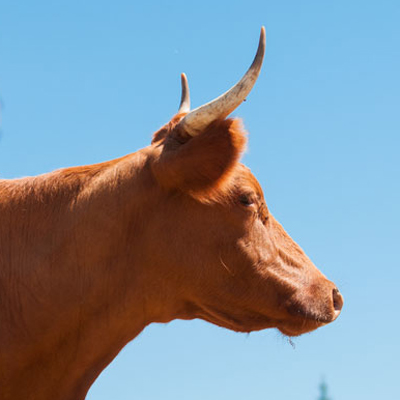 It won't be any surprise that we hit Craigslist once again for our first cattle. We had a less than stellar kick off with a nasty tempered Shorthorn cross whom we named Cheeseburger, although he did taste darn fine due to his earlier than normal demise. I've always had a love affair with Charolais, but after the shenanigans with Cheeseburger it became painfully clear that with my mobility impairment, working around full size cattle was a real no go. So, like any prudent gimpy woman would do, I threw the Charolais and our first year's worth of lambs into our "new" horse trailer (also a Craigslist purchase-sense a theme here?) and drove off to Arizona for Sheep is Life, a sheep show and educational event run by the Navajo nonprofit Diné be’iiná. Along the way, I traded the Charolais for a small flock of Navajo-Churros, in addition to the ones I'd commited to buy at SIL. The Cheeseburger incident was a real good lesson on researching breeds BEFORE buying, and it took a lot of reading before I finally settled on Irish Dexters as our next foray into the world of beef. We've had Irish Dexters now for six years, and while we adore some of them, there's definitely a few quirks to running Dexters as well. After a lot of soul searching, we finally decided to quit breeding cattle all together, and we're slowly phasing out our Irish Dexters. The main reason is that while running sheep and cattle together is great for maximizing grazing, it's a real pain to manage the two in tighter quarters during the winters when we have our animals confined to sacrifice pasture. The cows, even when not meaning to, can be pretty dangerous to the sheep, and a few cows have developed active aggressions towards the sheep and llamas. While Dexters are smaller than conventional beef cattle, an 800 lb angry cow with horns is still no joke to mess around with.
It won't be any surprise that we hit Craigslist once again for our first cattle. We had a less than stellar kick off with a nasty tempered Shorthorn cross whom we named Cheeseburger, although he did taste darn fine due to his earlier than normal demise. I've always had a love affair with Charolais, but after the shenanigans with Cheeseburger it became painfully clear that with my mobility impairment, working around full size cattle was a real no go. So, like any prudent gimpy woman would do, I threw the Charolais and our first year's worth of lambs into our "new" horse trailer (also a Craigslist purchase-sense a theme here?) and drove off to Arizona for Sheep is Life, a sheep show and educational event run by the Navajo nonprofit Diné be’iiná. Along the way, I traded the Charolais for a small flock of Navajo-Churros, in addition to the ones I'd commited to buy at SIL. The Cheeseburger incident was a real good lesson on researching breeds BEFORE buying, and it took a lot of reading before I finally settled on Irish Dexters as our next foray into the world of beef. We've had Irish Dexters now for six years, and while we adore some of them, there's definitely a few quirks to running Dexters as well. After a lot of soul searching, we finally decided to quit breeding cattle all together, and we're slowly phasing out our Irish Dexters. The main reason is that while running sheep and cattle together is great for maximizing grazing, it's a real pain to manage the two in tighter quarters during the winters when we have our animals confined to sacrifice pasture. The cows, even when not meaning to, can be pretty dangerous to the sheep, and a few cows have developed active aggressions towards the sheep and llamas. While Dexters are smaller than conventional beef cattle, an 800 lb angry cow with horns is still no joke to mess around with.
So, it shouldn't really come to anybody's surprise that running a ranch is a lot like running any other kind of business. You have a business plan, you have a profit-loss margin, you have logos and trademarks, marketing and branding, and all the legal paperwork that goes with all of it. Yet many small farmers and ranchers get caught flat footed on the business management side of the house, and I wasn't any real exception to that rule. 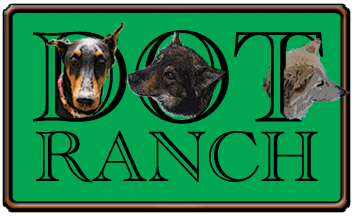 I've said this before, and I'll say it again, there's a far cry between working on somebody else's ranch, and running your own. When we first named Dot Ranch, it was actually Bob's idea that led to our name and initial logo. When he said "Dot Ranch", I immediately quipped "Because we're so small?" to which Bob replied "No, DOT Ranch. You know, for Danni, Otter, and Tundra. We can have their faces poking out around the letters for the logo." Danni was my son's service dog, Otter and Tundra were two wolves who had come from a wolf rescue in Southern Oregon, and they'd been my beloved companions (never pets) of 13 years. Dot Ranch really was small as a dot by usual ranch standard sizes, so the name stuck. The original logo, however, did not. A business consultant chided us very firmly that a business which sells food should not have a logo with dogs on it, lest people wonder if they're either A) buying dog food, or worse yet, B) buying dog meat. With a bit of hemming and hawing, we changed our label for our meat line, but clung to the original logo for our wool and fiber product sales. Finally, in the spirit of cohesion, we settled on one new logo for all products. Marketing doesn't come easily to me, so listening to business consultants was something which probably, though painful, did quite a bit to guide us in some better for the bottom line directions.
I've said this before, and I'll say it again, there's a far cry between working on somebody else's ranch, and running your own. When we first named Dot Ranch, it was actually Bob's idea that led to our name and initial logo. When he said "Dot Ranch", I immediately quipped "Because we're so small?" to which Bob replied "No, DOT Ranch. You know, for Danni, Otter, and Tundra. We can have their faces poking out around the letters for the logo." Danni was my son's service dog, Otter and Tundra were two wolves who had come from a wolf rescue in Southern Oregon, and they'd been my beloved companions (never pets) of 13 years. Dot Ranch really was small as a dot by usual ranch standard sizes, so the name stuck. The original logo, however, did not. A business consultant chided us very firmly that a business which sells food should not have a logo with dogs on it, lest people wonder if they're either A) buying dog food, or worse yet, B) buying dog meat. With a bit of hemming and hawing, we changed our label for our meat line, but clung to the original logo for our wool and fiber product sales. Finally, in the spirit of cohesion, we settled on one new logo for all products. Marketing doesn't come easily to me, so listening to business consultants was something which probably, though painful, did quite a bit to guide us in some better for the bottom line directions.
Recognizing Indigenous History in Our Local Ecology.
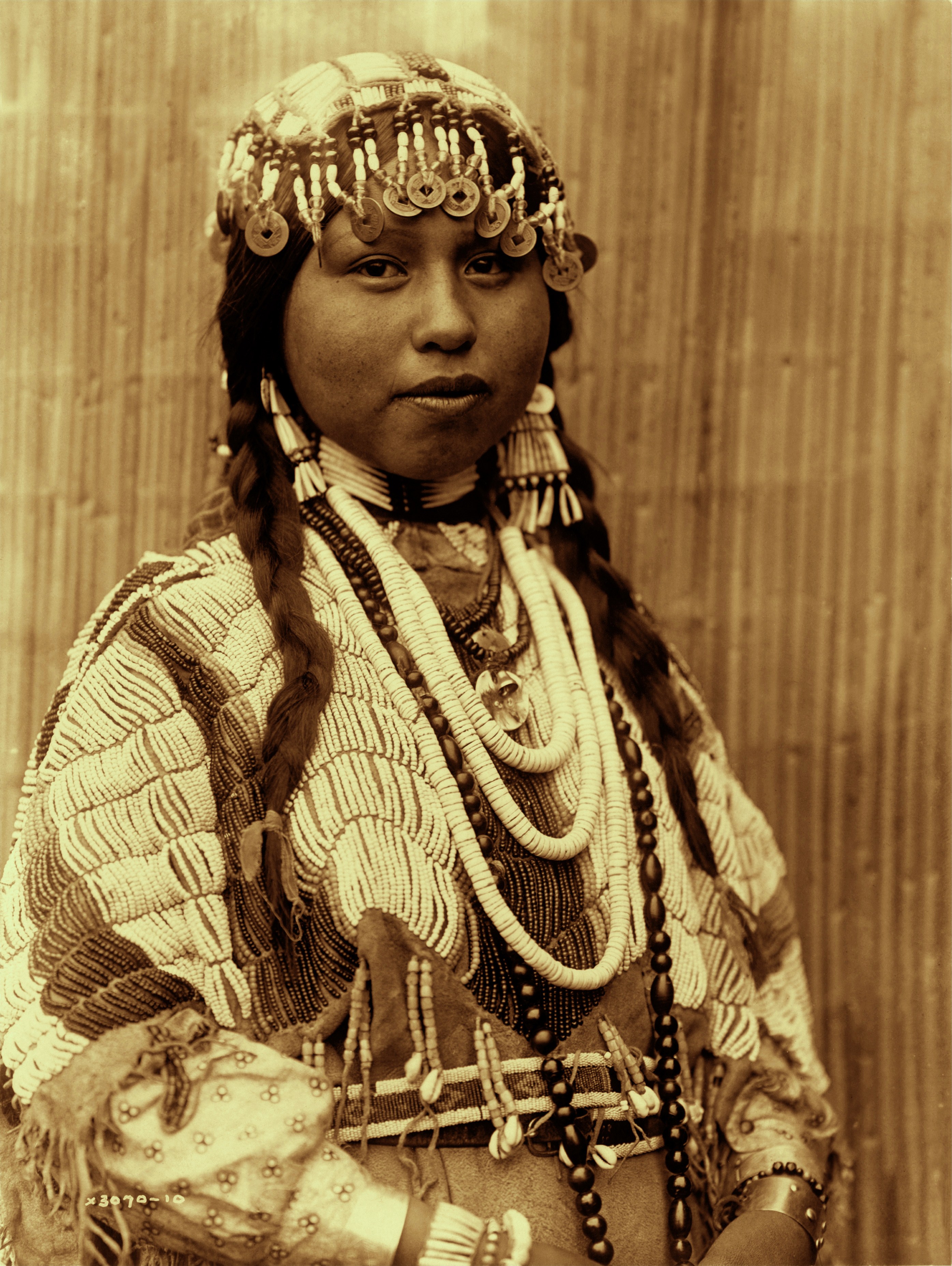 It is an unfortunate fact that most of history in the America's, particularly North America, has been white washed in the ongoing cycle of colonization. When most people imagine this country prior to European invasion, they have an ideal of sweeping expanses of untouched lands, with a few isolated pockets of wild aboriginal tribes. In truth, the America's had a population boasting between 50 million to 100 million, several advanced societies, and a human history that may possibly predate European civilization.1,2,3 Modern science widely recognizes that far from being an untouched wilderness, most of North America was actually managed by Indigenous peoples through a complex mixture of grazing management, fire management, and intentional suppression and fostering of specific plant communities.4 Oregon's history is full of examples of American Indian manipulation of the environment to manage for both game, plants, and fish. The land that Dot Ranch is on is no different, and once was managed by the Kalapuya Indians as an oak savannah, one of the richest inland ecosystems in terms of biodiversity and fertility.5
It is an unfortunate fact that most of history in the America's, particularly North America, has been white washed in the ongoing cycle of colonization. When most people imagine this country prior to European invasion, they have an ideal of sweeping expanses of untouched lands, with a few isolated pockets of wild aboriginal tribes. In truth, the America's had a population boasting between 50 million to 100 million, several advanced societies, and a human history that may possibly predate European civilization.1,2,3 Modern science widely recognizes that far from being an untouched wilderness, most of North America was actually managed by Indigenous peoples through a complex mixture of grazing management, fire management, and intentional suppression and fostering of specific plant communities.4 Oregon's history is full of examples of American Indian manipulation of the environment to manage for both game, plants, and fish. The land that Dot Ranch is on is no different, and once was managed by the Kalapuya Indians as an oak savannah, one of the richest inland ecosystems in terms of biodiversity and fertility.5
Rather than an unoccupied waste of wilderness, this area has always been an oasis of symbiotic relationships between humans and nature. The Kalapuya were as essential to the land as the land was to them, for it was only their management practices which created and preserved the oak savannahs and prairies which dominated Oregon's western side.6 These prairies spanned from the lower slopes of the Cascades down into the Willamette Valley were home to large and small game, and a wealth of medicinal and edible plants that we’re just now beginning to rediscover. Without the frequent fires and careful cultivation of desired plants, the prairie would have quickly become choked with underbrush. With the land kept free of the thick brush, the elk and deer were free to graze, which promoted the protein rich growth of the prairie’s perennial grasses. This interplay between the quick growing grasses, the mature and tough oak trees, grazing animals, and the controlled burning practiced by the Kalapuya Indians, all contributed to a synergistic effect between human and the natural world.5 The results were one of the most complex biological systems to exist outside of the coral reef. With the removal of the Kalapuya Indians, the strict fire control policies of the twentieth century, and the increase in monoculture coniferous stands for timber production, the oak savannah almost passed into extinction.7
Ecological Restoration and our Ongoing Mission.
 One of my professors at Oregon State University often said "Ecological restoration isn't about turning back the clock, it's about finding a new balance that works with what you have." It's foolish to think that we can put everything back to the way things once were, but that doesn't mean it's foolish to try to conserve and repair what we have left. Restoring the oak savannah here on Dot Ranch is an ongoing project, and one that has multiple focuses and a whole lot of juggling to accomplish. I like to think that it's about more than just the trees and the grass. It’s about providing a place for those insects which keep the food on our plates with their oft-overlooked but irreplaceable pollination services. It’s about saving our songbirds, preserving our forests from invasive and destructive beetles, and ensuring that the majestic progression of a young buck into an old and stately crowned stag can continue. Restoring our oak savannahs is about making sure that our great-great-grand children can enjoy fresh fruit, vegetables, and the multi-colored miracle that is an Oregon meadow in spring’s green grip.
One of my professors at Oregon State University often said "Ecological restoration isn't about turning back the clock, it's about finding a new balance that works with what you have." It's foolish to think that we can put everything back to the way things once were, but that doesn't mean it's foolish to try to conserve and repair what we have left. Restoring the oak savannah here on Dot Ranch is an ongoing project, and one that has multiple focuses and a whole lot of juggling to accomplish. I like to think that it's about more than just the trees and the grass. It’s about providing a place for those insects which keep the food on our plates with their oft-overlooked but irreplaceable pollination services. It’s about saving our songbirds, preserving our forests from invasive and destructive beetles, and ensuring that the majestic progression of a young buck into an old and stately crowned stag can continue. Restoring our oak savannahs is about making sure that our great-great-grand children can enjoy fresh fruit, vegetables, and the multi-colored miracle that is an Oregon meadow in spring’s green grip.
While controlled burning is no longer possible because of the population constraints of permanent residents, grazing has been found to be a suitable replacement by prairie restoration ecologists and practitioners.8 Dot Ranch showed a prime example of that, as well as a sobering reflection of what happens when both grazing and fire are removed from the equation. 25 years of grazing by cattle had freed these few bitter tasting oak seedlings, allowing them to mature into acorn bearing trees. The cows hadn’t been here for half a decade, and already, the ground was a carpet of evergreen seedlings threatening to overwhelm those lonely last stands of oak. Dense underbrush and encroachment by Himalayan Blackberries had built up a dangerous amount of tinder and ladder fuels, leaving the ominous threat of a spark or lightning strike being able to set off a fire that could quickly rage up into the canopy of the trees, where it could rage across the mountain and destroy homes and forest alike. I knew that if we were going to save the oaks here, we needed to bring back the selective pressures of grazing, but we needed to be careful with our introductions and management practices.
Despite the common misperception of sheep as destructive grazers, there's a growing recognition of their importance and ability at restorational grazing.8 This is due to the versatility of sheep in their grazing and browsing habits. While most people assume sheep eat grass, they in fact prefer to do a mixture of browsing and grazing, eating forbes and shrubs over grass if given the chance.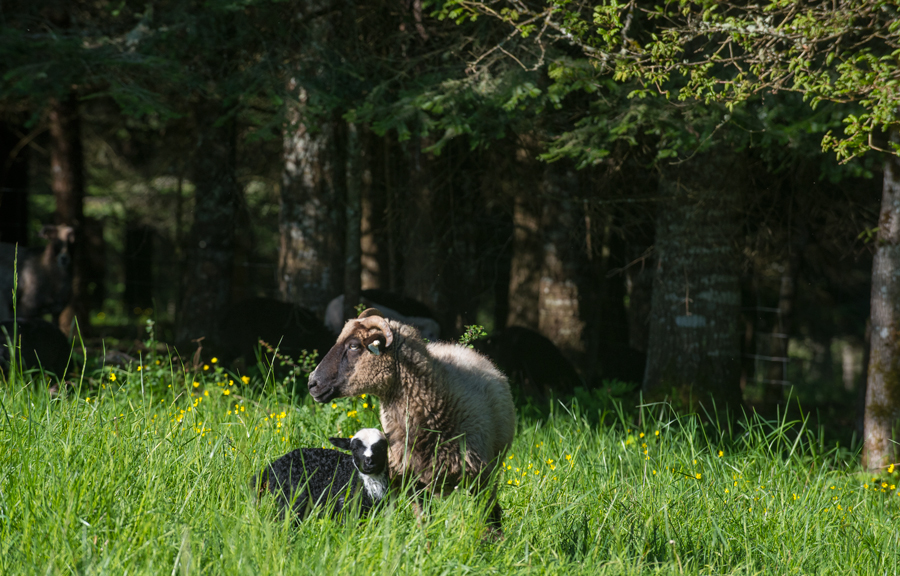 Navajo-Churro Sheep take it a step further. They produce wool, milk, and meat, and they are capable of thriving on forage that would leave other sheep breeds starving to death. Furthermore, they are invaluable for grazing tansy, ragwort, leafy spurge, blackberries, scotch broom, and thistles. They prefer evergreens to oaks, and they generally don't eat acorns unless there's nothing else to graze. In short, they were the perfect fit for my goals of ecological restoration through grazing and timber management. With a rich cultural tradition of their own, Navajo-Churro Sheep also helped us maintain ties to my son's paternal family, and gave me a focus with quicker results than the slow process of ecological restoration. A breed listed as Threatened by The Livestock Conservancy, they had been critically endangered until the past few decades. Some reports say there were as few as 470 Navajo-Churro sheep left in the 1970's. We do feel obligated to point out that this number would be hard to definitively prove given the long history of resistance to outside interference, and the tragic influence of stock reductions which has dogged the Navajo Nation.9 In order to contribute towards the restoration of the breed, we maintain a high level of genetic diversity within our flock, bolstered by annual trips to Navajo Nation to do trade, sales, and purchases with other Navajo-Churro breeders who aren't on the usual list of recognized names. For more details about our sheep, be sure to check out the Navajo-Churro Sheep section of this site.
Navajo-Churro Sheep take it a step further. They produce wool, milk, and meat, and they are capable of thriving on forage that would leave other sheep breeds starving to death. Furthermore, they are invaluable for grazing tansy, ragwort, leafy spurge, blackberries, scotch broom, and thistles. They prefer evergreens to oaks, and they generally don't eat acorns unless there's nothing else to graze. In short, they were the perfect fit for my goals of ecological restoration through grazing and timber management. With a rich cultural tradition of their own, Navajo-Churro Sheep also helped us maintain ties to my son's paternal family, and gave me a focus with quicker results than the slow process of ecological restoration. A breed listed as Threatened by The Livestock Conservancy, they had been critically endangered until the past few decades. Some reports say there were as few as 470 Navajo-Churro sheep left in the 1970's. We do feel obligated to point out that this number would be hard to definitively prove given the long history of resistance to outside interference, and the tragic influence of stock reductions which has dogged the Navajo Nation.9 In order to contribute towards the restoration of the breed, we maintain a high level of genetic diversity within our flock, bolstered by annual trips to Navajo Nation to do trade, sales, and purchases with other Navajo-Churro breeders who aren't on the usual list of recognized names. For more details about our sheep, be sure to check out the Navajo-Churro Sheep section of this site.
Citations
1 First humans arrived in North America a lot earlier than believed
2 Climate Change drove early humans to leave Africa in four waves beginning 100,000 years ago
3 Mann, C. C. (2005). 1491: New Revelations of the Americas Before Columbus. New York: Knopf.
4 Berkes, F., Colding, J., & Folke, C. (2000) Rediscovery of Traditional Ecological Knowledge as Adaptive Management. Ecological Applications, 10(5), 1251-1262.
5 Boyd, R. (1999). Indians, Fire, and the Land in the Pacific Northwest. Corvallis, OR: OSU Press.
6 Oregon College of Education & Central Oregon Community College (1973). Man and the Land; Environmental Perspectives of the Native American in Early Oregon, Monmouth, OR.
7 McShea, W.J. & Healy, W.M. (Eds). (2002). Oak Forest Ecosystems: Ecology and Management for Wildlife. Baltimore, MD: The John Hopkins University Press.
8 Collins, S. L., & Smith, M. D. (2006). Scale-Dependent Interaction of Fire and Grazing on Community Heterogeneity in Tallgrass Prairie. Ecology, 87(8), 2058-2067.
9 Weisiger, M. (2009). Dreaming of Sheep in Navajo Country. Seattle, WA: University of Washington Press.
